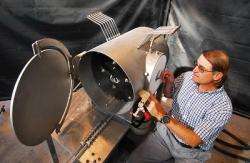Sandia researcher Rich Diver assembles a prototype device intended to chemically reenergize carbon dioxide into carbon monoxide, which ultimately could become the building block to synthesize a liquid combustible fuel. Photo by Randy Montoya.
(PhysOrg.com) -- Researchers at Sandia National Laboratories have built a machine that uses the sun's energy to convert carbon dioxide waste from power plants into transportation fuels such as gasoline, diesel, and jet fuel. The system could provide an alternative to carbon sequestration; instead of permanently storing CO2 underground, the CO2 could be recycled and put to use.
A prototype of the machine, which was invented by Sandia researcher Rich Diver, was tested recently for the first time.
Called the Counter-Rotating-Ring Receiver Reactor Recuperator (CR5), the cylindrical machine consists of two chambers on the sides and 14 rotating rings in the center. The outer edges of the rings are made of iron oxide. When the scientists heat the inside of one chamber to 1,500C with a solar concentrator, the iron oxide undergoes a thermo-chemical reaction where it gives up oxygen molecules. As the rings rotate (at one revolution per minute), the hot side approaches the opposite chamber and begins to cool down. When carbon dioxide is pumped into this chamber, the iron oxide retrieves oxygen molecules from the carbon dioxide, transforming it into carbon monoxide. The carbon monoxide could then serve as a building block to create a liquid combustible fuel.
Diver originally designed the machine to generate hydrogen without using electrolysis. By substituting water for the carbon dioxide in the second chamber, the researchers can make the machine produce hydrogen. Also, by mixing the resulting hydrogen with carbon monoxide, they can produce syngas.
It will probably take 15-20 years before the technology is ready for the market, with the biggest challenge being to increase the system's efficiency. The researchers' goal is to achieve an efficiency of a few percent, which is about twice as efficient as photosynthesis' real-world efficiency of 1%. One way to increase efficiency is to develop new ceramic composites that release oxygen molecules at lower temperatures.
"Ultimately, we believe we have to get in the range of 10% sunlight-to-fuels, and we're a long way from doing that," said James Miller, a chemical engineer with Sandia's advanced materials laboratory.
via: Technology Review
© 2009 PhysOrg.com




















